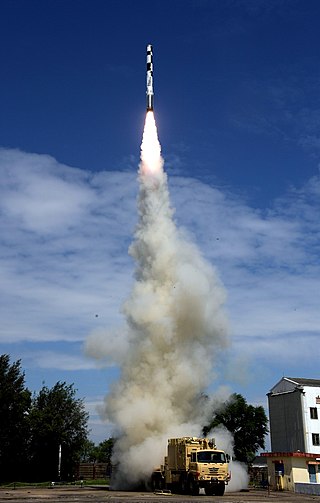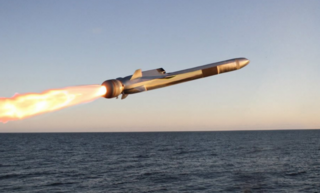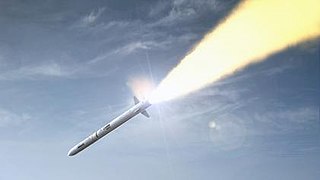Planned operators
 Norway
Norway
 Germany
Germany
| Super Sonic Strike Missile (3SM) Tyrfing |
|---|
Super Sonic Strike Missile (3SM) Tyrfing is a supersonic anti-ship missile under development by the Norwegian firm Kongsberg Defense & Aerospace (KDA).
The missile is expected to be delivered from 2035 and is planned to be used on Norwegian and German naval vessels. [1] The missile will complement the Naval Strike Missile. [2]
The name Tyrfing originates from Norse mythology, where it was a sword that always hit what it was swung at, could never rust and could cut through stone and iron as easily as through clothing.
In 2021 the Norwegian and German governments declared that a new anti-ship missile would become a collaborative project. The missile was initially called the Future Naval Strike Missile. [3]
In November 2023 the Norwegian Ministry of Defense and KDA proposed that a decision was to be made to initiate the first initial design phase of the project. Germany also plans to consider a decision on commissioning in the new year. [4]
In May 2024 Kongsberg announced they had teamed up with the German partners Diehl Defence and MBDA Deutschland GmbH for development of the missile. [5]

Kongsberg Gruppen is an international technology group headquartered in Norway, that supplies high-technology systems to customers in the merchant marine, defence, aerospace, offshore oil and gas industries, and renewable and utilities industries.
Kongsberg Defence & Aerospace (KDA) is one of three business units of Kongsberg Gruppen (KONGSBERG) of Norway and a supplier of defence and space related systems and products, mainly anti-ship missiles, military communications, and command and weapons control systems for naval vessels and air-defence applications. Today, the company is probably best known abroad for its development/industrialisation and production of the first passive IR homing anti-ship missile of the western world, the Penguin, starting delivery in the early 1970s. As of 2021, Kongsberg Defence & Aerospace had 3,500 employees.

The Advanced Short Range Air-to-Air Missile (ASRAAM), also known by its United States designation AIM-132, is an imaging infrared homing air-to-air missile, produced by MBDA UK, that is designed for close-range combat. It is in service in the Royal Air Force (RAF), replacing the AIM-9 Sidewinder. ASRAAM is designed to allow the pilot to fire and then turn away before the opposing aircraft can close for a shot. It flies at well over Mach 3 to ranges in excess of 25 kilometres (16 mi). It retains a 50 g maneuverability provided by body lift technology coupled with tail control.

MBDA is a European multinational developer and manufacturer of missiles. It was created in December 2001 after the merger of the main French, British and Italian missile systems companies; Matra, BAe Dynamics and Alenia. These were previously the missile subsidiaries of Aérospatiale-Matra, BAE Systems and Finmeccanica. The company's headquarters are located in Le Plessis-Robinson, France.

The Storm Shadow is a Franco-British low-observable, long-range air-launched cruise missile developed since 1994 by Matra and British Aerospace, and now manufactured by MBDA. "Storm Shadow" is the weapon's British name; in France it is called SCALP-EG. The missile is based on the French-developed Apache anti-runway cruise missile, but differs in that it carries a unitary warhead instead of cluster munitions.

The IRIS-T is a medium range infrared homing air-to-air missile available in both air-to-air and ground defence surface-to-air variants. It also is called AIM-2000.

The Aster 15 and Aster 30 are a Franco-Italian family of all-weather, vertical launch surface-to-air missiles. The name "Aster" stands for "Aérospatiale Terminale", with French company Aérospatiale having been the project's lead contractor before its missile activities were merged into MBDA. It also takes inspiration from the word "aster", meaning "star" in Ancient Greek. The missiles as well as the related weapon systems are manufactured by Eurosam, a consortium consisting of MBDA France, MBDA Italy and Thales, each holding a 33.3% share.

The MICA, abbreviated from its full name Missile d'Interception, de Combat et d'Auto-défense or alternate translation is a French anti-air multi-target, all weather, fire-and-forget short and medium-range missile system manufactured by MBDA France. It is intended for use both by air platforms as individual missiles as well as ground units and ships, which can be equipped with the rapid fire MICA Vertical Launch System. It is fitted with a thrust vector control (TVC) system. It was developed from 1982 onward by Matra. The first trials occurred in 1991, and the missile was commissioned in 1996 to equip the Rafale and Mirage 2000. It is a replacement for both the Super 530 in the interception role and the Magic II in the dogfighting role.

The Penguin anti-ship missile, designated AGM-119 by the U.S. military, is a Norwegian passive IR seeker-based short-to-medium range anti-ship guided missile, designed for naval use.

European multilateral defence procurement refers to the collective armaments purchasing policies of European nations.

The RIM-116 Rolling Airframe Missile (RAM) is a small, lightweight, infrared homing surface-to-air missile in use by the German, Japanese, Greek, Turkish, South Korean, Saudi Arabian, Egyptian, Mexican, UAE, and United States navies. It was originally intended and used primarily as a point-defense weapon against anti-ship missiles. As its name indicates, RAM rolls as it flies. The missile must roll during flight because the RF tracking system uses a two-antenna interferometer that can measure phase interference of the electromagnetic wave in one plane only. The rolling interferometer permits the antennas to look at all planes of incoming energy. In addition, because the missile rolls, only one pair of steering canards is required. As of 2005, it is the only U.S. Navy missile to operate in this manner.

The BrahMos is a medium-range ramjet supersonic cruise missile that can be launched from submarines, ships, fighter aircraft or TEL. It is a joint venture between the Indian Defence Research and Development Organisation (DRDO) and the Russian Federation's NPO Mashinostroyeniya, who together have formed BrahMos Aerospace. The missile is based on P-800 Oniks. The name BrahMos is a portmanteau formed from the names of two rivers, the Brahmaputra of India and the Moskva of Russia.
NASAMS is a distributed and networked short- to medium-range ground-based air defense system developed by Kongsberg Defence & Aerospace (KDA) and Raytheon. The system defends against unmanned aerial vehicles (UAVs), helicopters, cruise missiles, unmanned combat aerial vehicles (UCAVs), and fixed wing aircraft, firing any of a wide range of existing missiles.

The Naval Strike Missile (NSM) is an anti-ship and land-attack missile developed by the Norwegian company Kongsberg Defence & Aerospace (KDA).

The CAMM is a family of surface-to-air missiles developed by MBDA UK for the United Kingdom. CAMM is derived from, and shares some common features and components with, the Advanced Short Range Air-to-Air Missile (ASRAAM), but with updated electronics, a soft vertical launch system, and an active radar homing seeker. The CAMM family is either currently in-use or has been ordered by ten nations.

The Joint Strike Missile (JSM) is a multi-role, air-launched cruise missile under development by the Norwegian company Kongsberg Defence & Aerospace and American company Raytheon Missiles & Defense. The JSM is derived from the Naval Strike Missile.

The Polish Navy is the naval branch of the Polish Armed Forces. The Polish Navy consists of 46 ships and about 12,000 commissioned and enlisted personnel. The traditional ship prefix in the Polish Navy is ORP.
The FC/ASW, FMAN/FMC, FOSW or SPEAR 5 is a next generation missile programme launched by France and the United Kingdom in 2017 to succeed their jointly-developed Storm Shadow/SCALP as well as their respective Exocet and Harpoon anti-ship missiles. Equally funded by both countries, the project is led by European missile manufacturer MBDA and is a product of the close defence relationship set out between both nations by the Lancaster House treaties. In June 2023, it was announced Italy would join the programme and began allocating funding in November.
The Type 212CD class is a submarine class developed by ThyssenKrupp Marine Systems (TKMS) for the Norwegian and German navies. The class is derived from the Type 212 submarine class, but will be significantly larger than the 212 class.